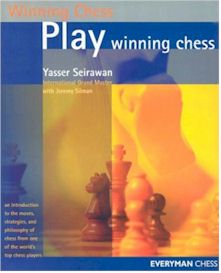Winning Chess 
 An Easytorecall Book Review
An Easytorecall Book Review
Back to: Chess Main Index
Winning Chess: Play Winning Chess
- By GM Yasser Seirawan with Jeremy Silman Everyman Publishers 2003 12.99
GM Seirawan starts this beginner’s guide to chess with a breezy and personable introduction. He sells the idea of chess as a "satisfying creative and combative game". Chess is "for young or old, black or white, male or female, jock or couch potato, cook or computer programmer". Seirawan loves chess and this radiates from the pages.
The teaching method in this book is interesting. At school I was taught by numbers: an introduction to the pieces, their values, the aim of the game, "don’t get the queen out too early" etc. Then it was on to tactics: pins, skewers, checkmates etc. After that, more advanced students might be given a detailed look at pawn structures and the like, but I was never afforded such status. Or maybe, like most of my peers, once given just enough info. to start playing, our chess developed in the heat of battle. Books were left dusty on the shelves, teachers were ignored. What little I learnt of strategy had to be gleaned over the years after painful losses!
Seirawan’s method is different. He takes the "advanced" concepts of chess and combines them into 4 principles. These principles are Force, Space, Time and Pawn Structure. He then places them before tactics in the order he teaches, and weaves them in with the relevant basics. A detailed discussion of tactics is left until the second book in the "Winning Chess" series.
This side stepping of tactics teaches the reader, right from the start, a valuable lesson about why and when tactics occur in a game. Seirawan explains this with an anecdote about Tal and Botvinnik. They had just drawn an exciting complex game and in the post mortem Tal listed a huge series of move variations thinking Botvinnik had arrived at the defence this way. But Botvinnik explained that he had made the defence using mostly general principles ... with almost no calculation involved!
Seirawan explains that tactics will normally only arise when someone has got a very definite advantage based on one or more of the 4 principles. Prior to this, one should be playing to increase these 4 principles using the methods advocated, and not looking for tactics that are probably not there.
These absolute basics are taught with a patience and clarity that you don’t always see when experts try to teach beginners. He starts with Force, which has to do with material advantage. Naturally at the same time the normal piece values (1 for a pawn 3 for a knight) are explained. There is the usual warning about looking at the position on the board and we are warned not to rely totally on ’the numbers racket’ Quick, one question,
quizzes test and further explain this.
The second principle is Time, with again all the essential advice woven into it. For example"don’t move a piece twice". In this way standard teaching mantras are easier to understand, accept and remember. And the fact that one should occasionally break these standard rules is easier to see since the reader is taught the basic principle behind them.
The third principle is Space, and here Seirawan’s Space count system is very easy to apply. The board is divided in half and each player ’owns’ the half nearest them. Seirawan’s system kicks in when any of your pieces controls any square outside of your own half. It is then easy to come up with a simple score, say 10-4 in White’s favour. Then we are told ways to play if one has, or does not have, a space advantage. For example, the player with more space should generally avoid swapping pieces. Lastly we come to Pawn Structure and by the end of the book the reader has been given a complete picture of chess. Of course there is still plenty to learn and painful defeats to take! But the reader should have more of an overview of why they have lost and how to correct it than I did when learning the game. Tactics and other chess knowledge can now be poured into this framework to add to the calm Botvinnik type overview the beginner has been given. In the next book in this "Winning Chess" series, Seirawan shows that he is not against us playing like Tal, he just wants us to play like Botvinnik as well!
Seirawan’s insight is that a student who is totally new to chess, can be trusted to understand advanced concepts right from square one. Seirawan’s skill is to entwine these together with basics that are relevant to each concept, and then sprinkle in appropriate quick quizzes, minibiographies and interesting facts, to create a brilliant textbook for absolute beginners.
This review was first published in Chess Today CT-914.
Graham Brown is a Freelance Journalist, technical editor of Chess Today and co-author of the Batsford book Chess on the Web
Can't find it?
Try our search engines, price comparison and online auction pages.

